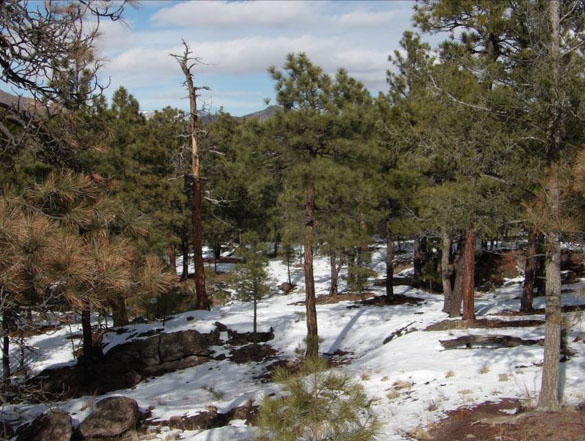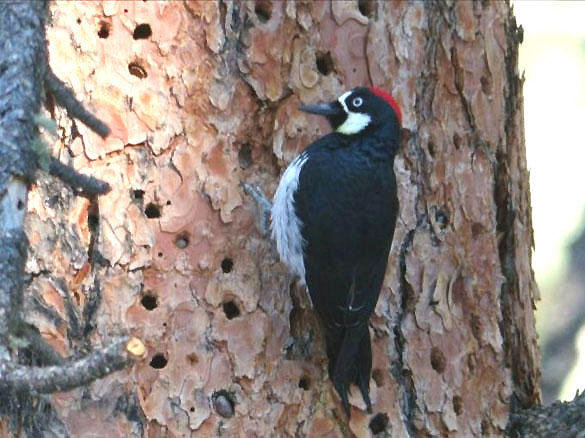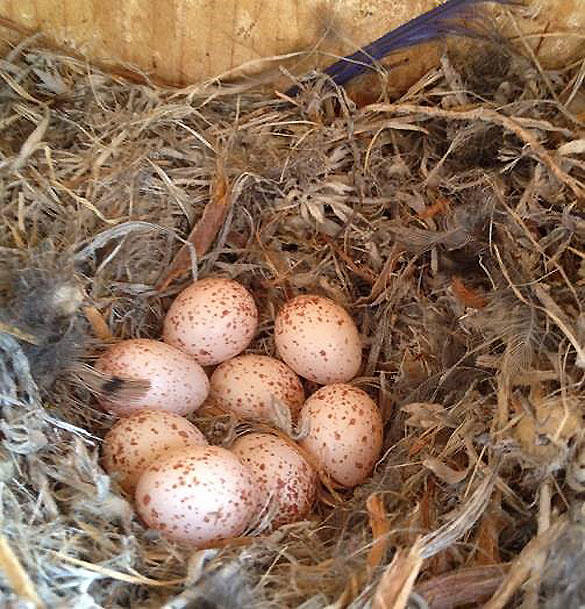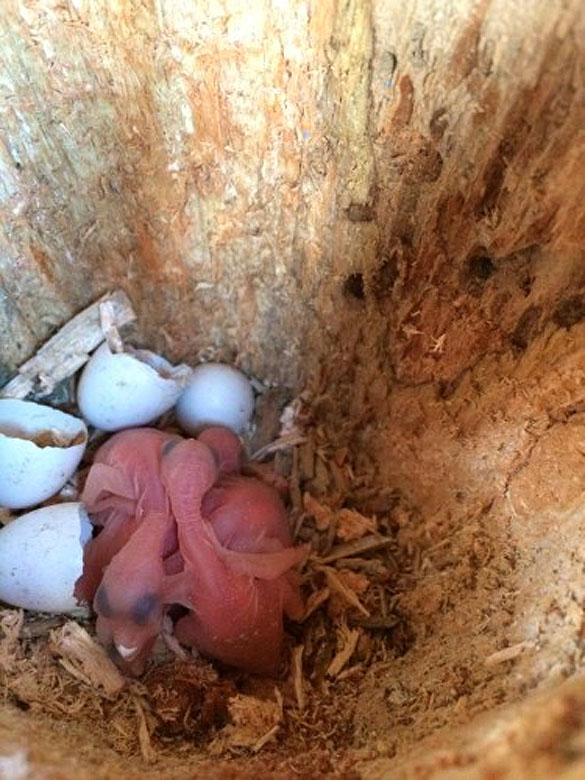 A dead ponderosa pine stands in the snow-covered forest floor of Acid Canyon. Photo by Robert Dryja
A dead ponderosa pine stands in the snow-covered forest floor of Acid Canyon. Photo by Robert Dryja An Acorn Woodpecker stores acorn seeds in the trunk of a dead ponderosa tree. Photo by Robert Dryja
An Acorn Woodpecker stores acorn seeds in the trunk of a dead ponderosa tree. Photo by Robert Dryja Eight eggs in a Pygmy Nuthatch nest. Photo by Priscilla Stuckey, PhD
Eight eggs in a Pygmy Nuthatch nest. Photo by Priscilla Stuckey, PhD By Robert Dryja
By Robert DryjaLos Alamos
February occurs in the depth of winter. The temperature may fall to about 20 degrees at night and rise to only slightly above freezing during the day.
Snow lasts for days on the ground when it is in the shadow of forest trees or canyon walls. However two species of birds still can be seen. Acorn woodpeckers and Pygmy Nuthatches remain for the winter. How have they adapted to winter with its lack of food and cold temperatures? Ponderosa pine trees are part of the answer. Both species can be seen among the Ponderosa trees along the hiking trails of Acid Canyon by the Nature Center.
Acorn woodpeckers have a close relationship with ponderosa trees. The woodpeckers benefit from the presence of dead ponderosa trees (called snags) or trees with dead branches. The woodpeckers use the trees for two purposes.
First, it is easier to peck into the softer wood of a dead tree or branch. The birds create cavities in which to raise young or to roost throughout the year. Second, some trees are used as granaries. The woodpeckers make hundreds to thousands of holes in which to store acorn seeds for the winter. An increasing number of woodpeckers is associated with an increasing number of snags and dead branches in a forested area.
The nesting cavities inside a tree provide a degree of insulation from the outside cold of winter. The cavities are made high in a tree to provide a protected location for raising nestlings. The cavities also are made large enough so that a group of woodpeckers may stay together, sharing their body warmth.
One part of a group is composed of several males and females that interbreed with one another. There may be 1 to 7 males and 1 to 3 females interbreeding with one another. The other part of the group is composed of younger woodpeckers that may stay with their parents for several years. These are referred to as helpers, assisting with the care of a new generation of hatchlings from year to year. Each helper woodpecker in a group therefore can have a different combination of male and females for its parents.
The Pygmy Nuthatch is another communal species of bird that nests in cavities. Young adult Pygmy Nuthatches from the preceding year may act as helpers for its parents, the same as occurs with young Acorn Woodpeckers.
However the parents are a single a pair rather than a blend of several males and females. Pygmy Nuthatches nest cooperatively and roost together in cavities on cold nights, again like acorn woodpeckers. “Nest cooperatively” means that all members work together to incubate and raise nestlings. Groups of Pygmy Nuthatches additionally gather into flocks to roost together in their cavities when not in the breeding season. Up to 150 have been seen roosting in a single tree.
Pygmy Nuthatches can reduce their body temperature with what is called controlled hypothermia. A lower metabolic rate results in a lower body temperature.
Rather than using food energy to maintain a higher body temperature, energy is conserved. This is a survival benefit when food is scarcer during the winter.
Pygmy Nuthatches therefore also can remain throughout the year because ponderosa trees provide a place for an extended communal home, similar to what occurs with Acorn Woodpeckers. Rather storing seeds for food, Pygmy Nuthatches instead reduce their need for food in the winter by reducing their metabolism.
The number of eggs of produced by Pygmy Nuthatches is remarkable. A clutch may include 5 to 9 eggs and occasionally there may be two broods in a summer.
A brooding cycle last for 26 to 39 days and then another cycle may begin. A brooding cycle includes the incubating of eggs and raising fledglings until they are ready to the leave the nest.
The food requirements to produce 5 eggs are monumental when considered on a proportional basis. A Pygmy Nuthatch weighs in the range of 9 to 11grams and its eggs weigh in the range of 0.9 to 1.6 grams.
Each egg therefore represents 10 to 15 percent of the weight of the mother bird. A mother bird lays one egg per day. This means that the equivalent of 50 of its body weight would be used to gestate 5 eggs. The percentages would go even higher for a larger number of eggs. A cooperative family effort is a good strategy to support the production of such a large number eggs and then raise the young.
Exploring down the Rabbit Hole —Learning more like Alice
Read more about Acorn Woodpeckers or Pygmy Nuthatches at:
Watch a video about Acorn Woodpeckers at:
 Newly hatched Acorn Woodpeckers huddling in their nest cavity. Photo by Steve Brenner
Newly hatched Acorn Woodpeckers huddling in their nest cavity. Photo by Steve Brenner Nine Pygmy Nuthatch nestlings piled together keeping warm. Photo by Linda Violett
Nine Pygmy Nuthatch nestlings piled together keeping warm. Photo by Linda Violett A Pygmy Nuthatch stops for a moment. Photo by Bob Walker
A Pygmy Nuthatch stops for a moment. Photo by Bob Walker
